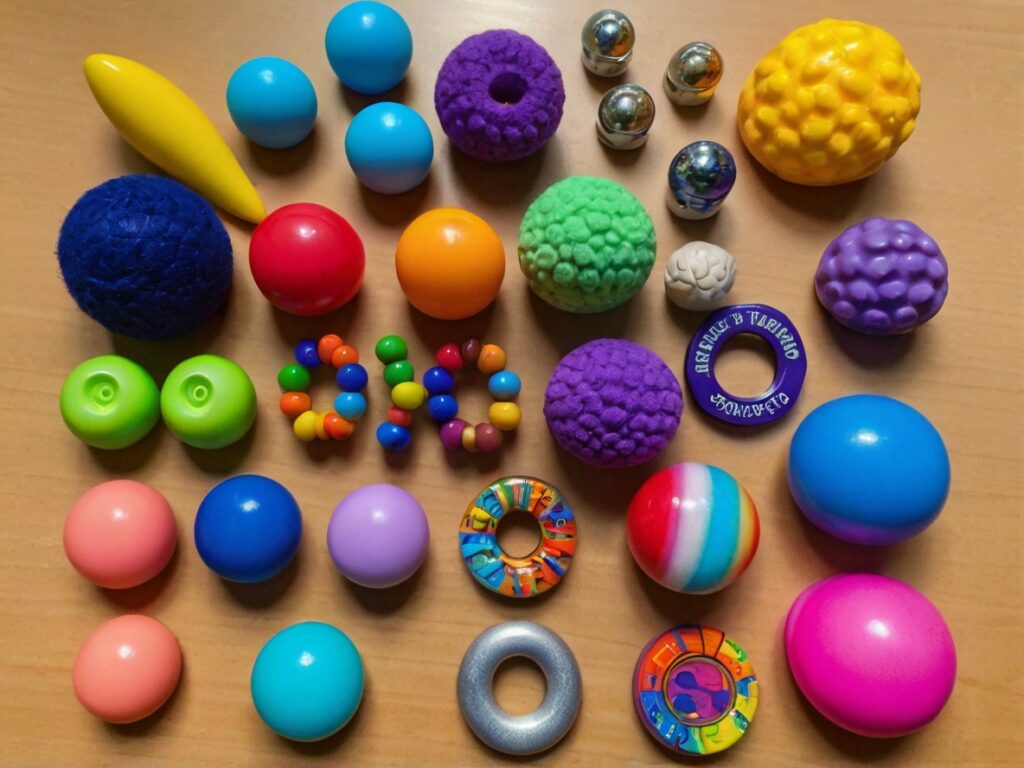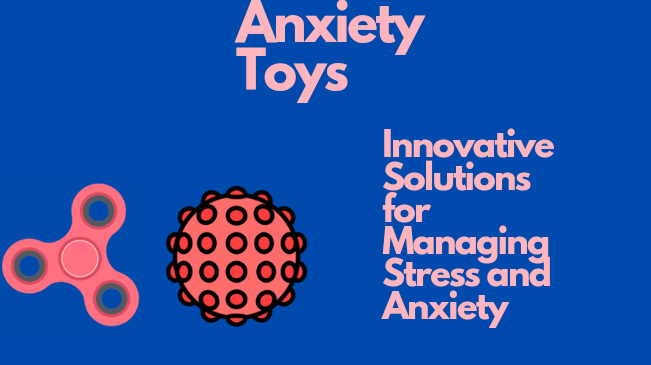It’s more crucial than ever to find efficient ways to handle anxiety in our fast-paced, high-stress environment. Anxiety toys have become a well-liked and creative way for people to deal with their stress and anxiety. These toys offer a straightforward yet efficient method of reducing anxiety symptoms because they are made to provide sensory input and distraction. This post will discuss the several kinds of anxious toys that are out there, the research underlying their efficacy, and how to use them in your day-to-day activities. Our goal in exploring the realm of anxiety toys is to bring you a thorough understanding of these cutting-edge instruments for relieving stress.

Table of Contents
The Science Behind Anxiety Toys
Investigating the underlying mechanisms is crucial in order to comprehend the efficacy of anxiety toys. Elevated arousal is a common symptom of anxiety, which can cause physical symptoms including tense muscles, a racing heartbeat, and restlessness. Anxious toys function by stimulating the senses, offering a center of concentration, and encouraging relaxation through tactile stimulation or repetitive actions.
Studies have indicated that the brain’s capacity to control emotions can be greatly impacted by sensory information. Fidgeting with an object, for example, can helphelp alleviate stress and divert attention from worried thoughts by activating the brain’s sensory regions. Additionally, by activating the parasympathetic nervousnervous system, which balances the body’s stress reaction, the repeated motions associated with utilizing anxious toys can aid in a relaxing impact.
Types of Anxiety Toys
Anxious toys are widely accessible, with each one catering to a distinct set of sensory requirements and preferences. These are a few well-liked categories:
1. Fidget Spinners and Cubes: These little, portable gadgets help focus attention and lower anxiety by offering tactile stimulation and repeated action. Fidget cubes have numerous sides with various sensory inputs, like buttons, switches, and gears; fidget spinners include a core bearing that permits the outer structure to spin.
2. Stress Balls: Stress balls are made of malleable materials and are intended to be squeezed and manipulated to release physical tension. Squeezing and letting go facilitatefacilitate relaxation and the release of stored energy.
3. Tactile Toys: These toys include a variety of textures that appeal to the sense of touch, such as squishy toys or textured putty. For those who struggle with anxiety, tactile stimulation can be very calming and grounding.
4. Sensory Rings and Bracelets: These rings and bracelets provide mild sensory input all day long,long, whether worn on the fingers or wrists. They offer ongoing anxiety alleviation and are discrete enough to be employed in a variety of contexts.
5. Weighted Blankets and Lap Pads: Deep pressure stimulation is a technique used by these goods to ease anxiety and encourage relaxation. Similar to receiving a hug, the light and and even pressure can help relax the nervous system.
How to Choose the Right Anxiety Toys
Taking into account both your individual preferences and the unique requirements of your anxiety is important when choosing the best anxious toys. The following advice will help you make your choice:
1. Identify Your Sensory Preferences: Find the sensory input types that you find most calming. Which do you prefer: deep pressure, repetitive motion, or tactile stimulation? The best anxiety toys will be easier for you to select if you are aware of your preferences.
2. Consider Portability: Small, portable toys that fit neatly in your pocket or purse are your best option if you need anxiety treatment on the go. For portability, stress balls, sensory rings, and fidget spinners are great options.
3. Evaluate Durability: Seek out materials that are strong, long-lasting, and able to tolerate repeated use. This is especially crucial for stress balls and tactile toys because they could be handled roughly.
4. Seek Professional Advice: Speak with a mental health expert if you’re not sure which anxiety toys are best for you. Personalized recommendations based on your unique requirements and interests can be offered by them.
Incorporating anxiety toys into your routine
You may easily incorporate anxious toys into your everyday routine to provide yourself with ongoing stress and anxiety relief. Here are a few realistic methods to apply them in your daily life:
1. During work or study: When you need to focus or feel stressed out, keep a stress ball or fidget spinner on your desk. The little sensory stimulation helps lessen anxiety and supports focus.
2. In social settings: Subtle anxious toys, such as sensory rings or bracelets, might be a relief without drawing attention if you suffer from social anxiety. Utilize these to help control your nervousness when interacting with people.
3. While Traveling: Extended travel or commuting might cause anxiety. When traveling, keep portable anxious toys in your bag as a soothing diversion.
4. At Bedtime: Weighted blankets are especially useful for enhancing the quality of your sleep. Deep-pressure stimulation facilitates relaxation and makes going to sleep easier.
5. During breaks: Throughout the day, take brief breaks to play with anxious toys. This can assist in resetting your neural system and preserving mental equilibrium.
Expert Insights on Anxiety Toys
We conferred with professional psychologist Dr. Emily Hughes, who specializes in anxiety disorders, in order to present a comprehensive viewpoint on anxious toys. Dr. Hughes states that anxiety toys “can be a useful tool for stress and anxiety management, especially when combined with other therapeutic approaches. “They provide a concrete means of self-soothing and are particularly beneficial for those who experience sensory overload.”
Incorporating anxiety toys into a comprehensive anxiety management regimen is crucial, according to Dr. Hughes. “Anxious toys can help instantly, but they shouldn’t be your only coping mechanism. It’s critical to treat the underlying causes of anxiety with medication, therapy, and lifestyle modifications as needed.”
The Benefits of Anxiety Toys for Different Age Groups
Anxiety toys are helpful for kids, teens, and adults of all ages. They are not just for kids. The following are some advantages for various age groups:
1. Children: Children with anxiety disorders, ADHD, or problems with their sensory processing can benefit from anxiety toys. They encourage concentration and serenity in learning environments and offer a secure release for pent-up energy.
2. Adolescents: Teenagers often face academic and social pressures that contribute to anxiety. Anxiety toys can offer a discreet way to manage stress and improve concentration during exams or social interactions.
3. Adults: Anxiety toys can be a useful tool for people to handle stress at work, social anxiety, or overall anxiety. They offer an easy-to-use method for managing emotions on a daily basis.
The Future of Anxiety Toys
Innovation in this industry is anticipated to develop as anxiety toys continue to gain popularity. The incorporation of technology, as shown in smart anxiety toys that monitor usage and offer feedback, and the creation of environmentally friendly materials to support sustainability are examples of emerging trends.
In order to increase the efficacy of other therapeutic methods like mindfulness and biofeedback, researchers are also looking into the possibility of integrating anxiety toys with them. Anxiety toys could lead to ever more advanced and individualized approaches to stress and anxiety management in the future.
Conclusion
Worry toys provide creative and practical ways to deal with tension and worry. They aid in promoting relaxation and calming the nervous system by offering sensory stimulation and diversion. There’s a huge selection of anxiety toys to fit various requirements and preferences, including weighted blankets, stress balls, tactile toys, fidget spinners, and sensory rings.
Including anxiety toys in your daily routine can help you feel less anxious all the time and improve your general wellbeing. They should, however, be used in conjunction with a thorough anxiety treatment strategy that addresses the underlying causes of anxiety through counseling, dietary adjustments, and expert advice.
Frequently Ask Questions(FAQ)
What are anxiety toys, and how do they work?
worry toys are devices made to divert attention and give sensory input in order to help people deal with stress and worry. They function by stimulating the senses, encouraging repetitive actions, or offering tactile stimulation, all of which can aid in attentional concentration and the alleviation of anxiety symptoms.
Are anxiety toys effective for both children and adults?
Absolutely, people of all ages, including kids, teens, and adults, can benefit from anxiety toys. In addition to offering advantages including increased attention, relaxation, and a sense of peace, they provide a useful method of managing stress and anxiety.
How do I choose the right anxiety toy for my needs?
When selecting an anxiety toy, take into account your needs for portability, your preferred senses (such as tactile stimulation, repeated motion, or deep pressure), and the toy’s durability. Seeking advice from a mental health specialist can also yield tailored suggestions according to your unique anxiety symptoms and preferences.
Can anxiety toys be used as a standalone treatment for anxiety?
Although anxiety toys can help reduce symptoms of anxiety right away, they shouldn’t be used as a stand-alone therapy. The root causes of anxiety must be addressed with all-encompassing management techniques, such as counseling, dietary adjustments, and, if required, pharmaceuticals.
What are some ways to incorporate anxiety toys into my daily routine?
Anxiety toys can be utilized in a variety of contexts, including the workplace, school, social situations, travel, bedtime, and breaks. Anxiety toys can help sustain a balanced state of mind and encourage relaxation throughout the day. Keep them handy and use them when under stress.
Are there any side effects or risks associated with using anxiety toys?
In general, anxiety toys are safe to use, but it’s crucial to select high-quality, non-toxic materials, particularly for younger users. The effectiveness of anxiety toys may be limited if they are overused in place of treatment for the underlying reasons for anxiety. They must be used in conjunction with a more comprehensive strategy for managing anxiety.
Can anxiety toys help with conditions other than anxiety?
Absolutely, anxiety toys are good for various problems like sensory processing disorders, ADHD, and autism spectrum disorders. They are adaptable instruments for a range of mental health and sensory requirements since they can lessen sensory overload, increase focus, and have a relaxing impact.

